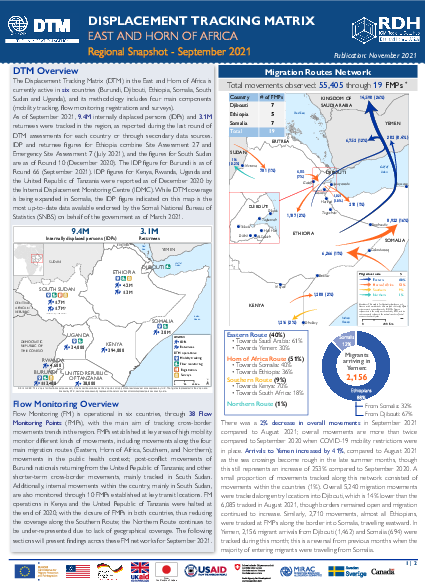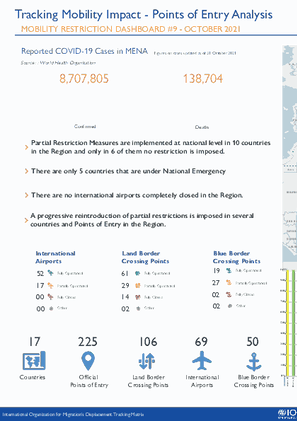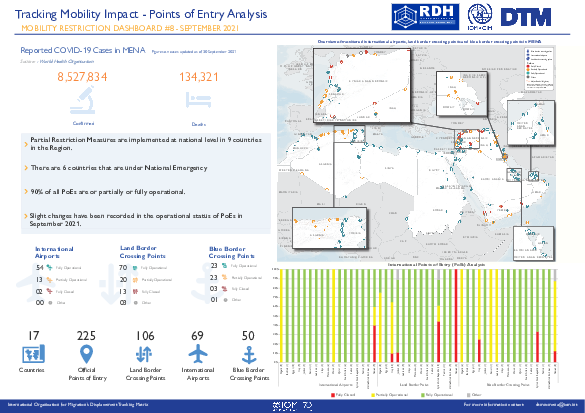-
Countries
-
Data and Analysis
-
Special Focus
-
Crisis Responses

Contact
DTM Djibouti, DTMDjibouti@iom.int
Language
French
Location
Djibouti
Period Covered
Oct 01 2021
Oct 31 2021
Activity
- Survey
- Flow Monitoring Survey
- Flow Monitoring
- Migrants presence
Ce tableau de bord présente les principales tendances migratoires observées à Djibouti en octobre 2021. Il vise à fournir une vue d'ensemble des principales dynamiques migratoires au niveau de Djibouti, en présentant des analyses à la fois quantitatives et qualitatives obtenues à travers plusieurs outils de collectes de données développées par l'OIM Djibouti.
Ce tableau de bord comprend:
- Une mise à jour mensuelle des principales données obtenues à travers l’enregistrement des flux aux 10 points de suivi des flux (FMP) actifs à Djibouti;
- Des données clés sur les retours spontanés du Yémen ainsi que sur les mouvements entre Djibouti et l'Éthiopie;
- Une mise à jour mensuelle sur les profils, vulnérabilités, parcours migratoires et intentions des personnes interrogées à travers les enquêtes individuelles (FMS);
- Une mise à jour sur la présence des migrants bloqués à Djibouti.

Contact
DTM Djibouti, DTMDjibouti@iom.int
Language
English
Location
Djibouti
Period Covered
Oct 01 2021
Oct 31 2021
Activity
- Survey
- Flow Monitoring Survey
- Flow Monitoring
- Migrants presence
This dashboard presents the main migration trends observed in Djibouti in October 2021. It aims to provide an overview of the main mobility trends in Djibouti, through both quantitative and qualitative analyses, obtained from several data collection tools developed by IOM Djibouti.
This dashboard includes:
- A monthly update on the key data obtained through the Flow Monitoring Registry (FMR) at the 10 active Flow Monitoring Points (FMPs) in Djibouti;
- Key data on spontaneous returns from Yemen and movements observed between Djibouti and Ethiopia;
- Anmonthly update on the profile, vulnerabilities, migratory experience and intentions of the migrants surveyed through the Flow Monitoring Surveys (FMS);
- An update on the presence of migrants stranded in Djibouti.
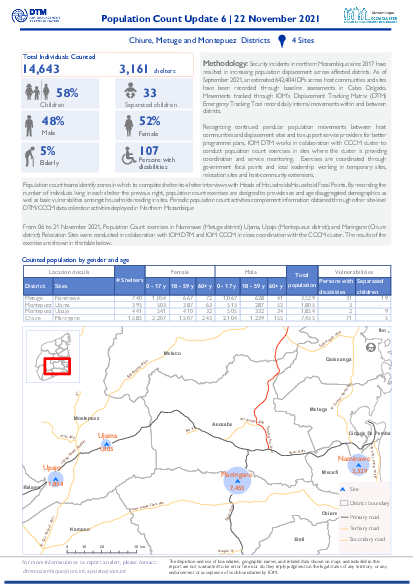
Contact
DTM Mozambique, DTMMozambique@iom.int
Language
English
Location
Mozambique
Period Covered
Nov 06 2021
Nov 21 2021
Activity
- Site Assessment
- Mobility Tracking
From 06 to 21 November 2021, Population Count exercises in Naminawe (Metuge district); Ujama, Upajo (Montepueuz district); and Maningane (Chiuredistrict) Relocation Sites were conducted in collaboration with IOM DTM and IOM CCCM in close coordination with the CCCM cluster. The results of the exercise are shown in the table below.
The Displacement Tracking Matrix (DTM) in the East and Horn of Africa is currently active in six countries (Burundi, Djibouti, Ethiopia, Somalia, South Sudan and Uganda), and its methodology includes four main components (mobility tracking, flow monitoring, registrations and surveys).
As of September 2021, 9.4M internally displaced persons (IDPs) and 3.1M returnees were tracked in the region, as reported during the last round of DTM assessments for each country or through secondary data sources.
This report summarises the operational status of the air, sea and land crossing in MENA countries
The report summarizes the operational status of air, sea and land crossing points in MENA countries.
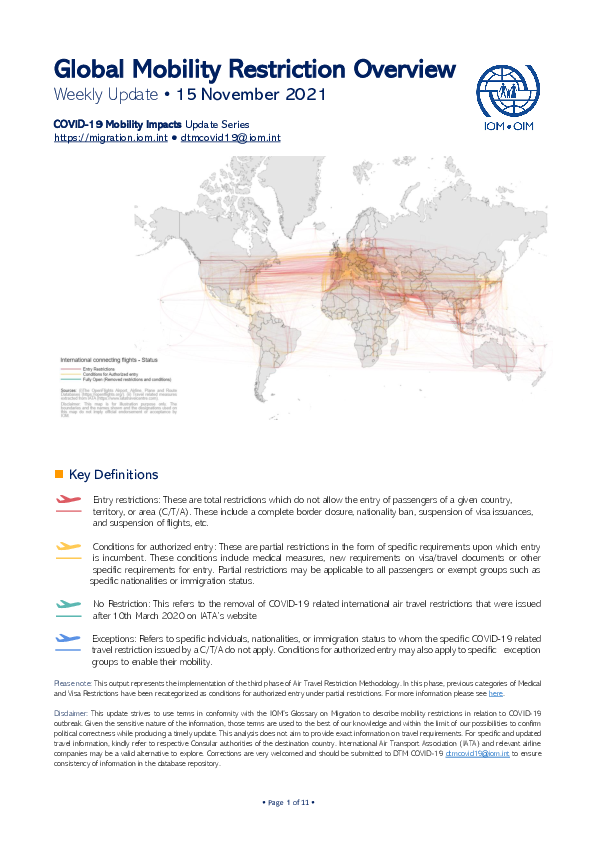
Contact
DTMcovid19@iom.int
Language
English
Location
Global
Snapshot Date
Nov 15 2021
Activity
- Other
The current outbreak of COVID-19 has affected global mobility in the form of various travel disruptions and restrictions. To better understand how COVID-19 affects global mobility, DTM has developed a COVID-19 database mapping the different restrictions to provide a global overview. For this, DTM uses the IATA site as the primary source of restrictions with the information reported per country and territory, and to the country of application.
Data collected includes:
- Date of restriction
- Country, territory or area of restriction
- Countries, territories or areas on which restrictions were imposed
- Type of restriction- total restriction, or conditional restriction – such as medical/ and or visa restriction
This DTM COVID-19 Travel Restrictions Output presents an analysis based on country imposing, the country being imposed upon, and the aggregation of the restriction type. The aim of the data analysis is to provide an overview of the COVID-19 outbreak on global mobility and to help identify and develop responses.
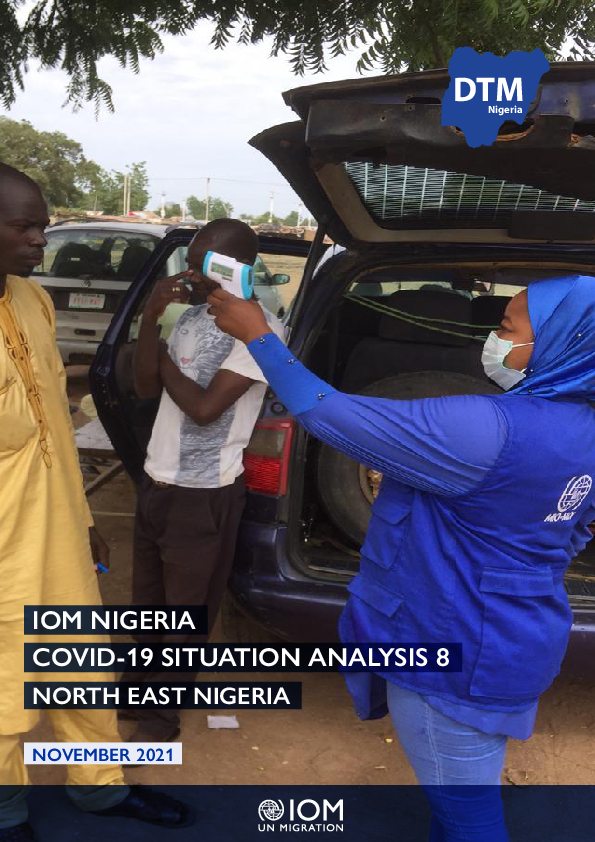
Contact
DTM Nigeria, AllUsersInDTMNigeria@iom.int
Language
English
Location
Nigeria
Period Covered
Aug 30 2021
Oct 15 2021
Activity
- Site Assessment
- Mobility Tracking
This Round 8 of the COVID-19 Situation Analysis is based on the assessment of knowledge, practice and impact
of the pandemic on internally displaced persons (IDPs) in conflict-affected communities of North East Nigeria.
Conducted by the Displacement Tracking Matrix (DTM) unit of the International Organization for Migration
(IOM), the report covers the period between 30 August and 15 October 2021 and reflects trends from the states
Adamawa, Bauchi, Borno, Gombe, Taraba and Yobe in North East Nigeria.
The first assessment was conducted in May 2020 two months after the index case was reported in Nigeria. In this
report, the results are presented from the 8th round of assessments. In this Round 8, 122,644 respondents - or 6
per cent of all identified IDPs as per DTM Round 39 - were interviewed for a range of COVID-19 related indicators.
Key informant interviews and focus group discussions were the primary methods used for the assessment and the
findings were corroborated with physical on-ground observations.

Contact
DTM Chad, dtmtchad@iom.int
Language
French
Location
Chad
Period Covered
Feb 17 2021
Mar 17 2021
Activity
- Other
- Mobility Tracking
Depuis 2015, le Tchad fait l’objet d’attaques perpétrées par des groupes armés non-étatiques présents dans le bassin du Lac Tchad engendrant des déplacements massifs de populations, aussi bien internes que transfrontaliers. Dans ce contexte mélangeant des déplacements prolongés et nouveaux, il est crucial de disposer des outils de collecte des données permettant d’orienter aussi bien les stratégies purement humanitaires que les stratégies de transition vers le développement. Ainsi, la DTM met en œuvre plusieurs outils dans la province du Lac dont l’indice de stabilité.
Ce rapport présente les résultats du premier round de l’indice de stabilité dans la Province du Lac, réalisé entre février et mars 2021. Cet outil a été piloté au Tchad, Nigeria et Cameroun en 2019 et a été officiellement lancée dans ces trois pays et le Niger en 2021.
L’indice de stabilité a pour but d’évaluer le niveau de stabilité des zones accueillant des populations déplacées dans le Bassin du Lac Chad et ressortir les facteurs influençant ce niveau de stabilité. L’objectif ultime est de permettre une programmation ciblée dans les localités selon leur stabilité et ainsi permettre des interventions cohérentes qui lient les approches humanitaires, de transition et de développement selon la situation de localités.
L'indice de stabilité est basée sur des données collectées par le biais d’entretiens avec des informateurs clés au niveau de la localité (niveau administratif le plus bas possible). Cet indice met en corrélation une trentaine d’indicateurs relatifs aux conditions de vie des populations, regroupés en trois échelles permettant de calculer un score de stabilité dans les zones accueillant les populations déplacées. Les échelles sont les suivantes : 1) accès aux services de base et aux moyens de subsistance, 2) niveau de cohésion sociale et 3) niveau de sécurité.
Ces indicateurs sont issus des résultats de récentes recherches quantitatives et qualitatives sur les dynamiques dans les contextes post-conflits. Ils sont représentatifs des conditions de vie minimales en-deçà desquelles la stabilité n’est pas suffisante pour favoriser des solutions durables.
Les données présentées dans ce rapport ont été collectées entre le 17 février et le 17 mars 2021 dans 228 localités dont 171 sites et 57 villages.
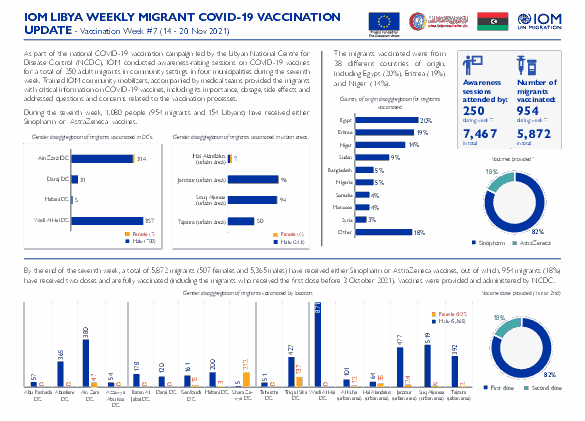
Contact
DTM Libya, DTMLibyateam@iom.int
Language
English
Location
Libya
Period Covered
Nov 14 2021
Nov 20 2021
Activity
- Other
As part of the national COVID-19 vaccination campaign led by the Libyan National Centre for Disease Control (NCDC), IOM conducted awareness-raising sessions on COVID-19 vaccines for a total of 250 adult migrants in community settings in four municipalities during the seventh week. Trained IOM community mobilizers, accompanied by medical teams provided the migrants with critical information on COVID-19 vaccines, including its importance, dosage, side effects and addressed questions and concerns related to the vaccination processes. During the seventh week, 1,080 people (954 migrants and 154 Libyans) have received either Sinopharm or AstraZeneca vaccines.
